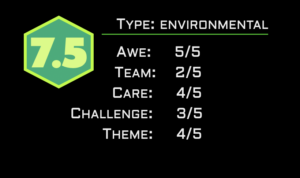
Review by Michael
 This is a pirate-themed room has a deeper-than-usual story. It starts in an average-looking tavern. An initially tasteless script improves after an early scene where an automated NPC is — spoilers — on the toilet. But set-pieces become more and more impressive as the admirably showy story pushes forward, even if it never quite pushes through “excellent” into “legendary”
This is a pirate-themed room has a deeper-than-usual story. It starts in an average-looking tavern. An initially tasteless script improves after an early scene where an automated NPC is — spoilers — on the toilet. But set-pieces become more and more impressive as the admirably showy story pushes forward, even if it never quite pushes through “excellent” into “legendary”
This doesn’t matter if you already live in Barcelona. And even if you’re visiting for the escape rooms alone, this should probably still be on your itinerary, but missing out on it would be less than tragic. That’s not to take anything away from the 9 1/2 rooms of mostly-functional puzzle-scenery. In spectacle, things usually land between a healthy wow-factor and something genuinely next level. But it’s never quite next-level.
Remember that you’re not in the United States, and accessibility isn’t always the priority in Europe that it is in America. The trade-off is understandable, as there are experiences of climbing, of hidden access-points, and of shifting scenery that just wouldn’t fly in the US. It’s nice to know you can experience such things someplace, and if you’re traveling with kids, there are points at which they might think a genie was granting them a long-standing wish. (These are the same points where a lot of parents would groan, “you’re kidding me”, but live a little, and bring ibuprofen. There’s only about four places where I, at the age of 45, thought I might be too old to be doing this. The other solver playing with me is 35, and he felt the same way. Your mileage will vary).
The room can be played in English, and truly does rely on players’ ability to understand the script. Hard-working and charismatic actors provide hints (not always at appropriate times, it must be admitted) and the story is coherent overall. Even so, even the cleverest of their puzzles lack coherent connection to the story, and this undermines the grandeur of some magnificently staged moments.
While the scenery and storyline do become more intensely merged as you progress, the lack of necessity for each puzzle becomes more and more noticeable. This flaw is not everywhere — there are some places where the challenges make a wonderful amount of sense. But more frequently than not, we moved past a room thinking “well, it’s lucky we eventually figured out what on earth we were expected to do…” but when it wasn’t the actors helping us, discovering the solution felt more like happenstance than like being involved in the escape.
It’s a good example of a well-made play, to the extent that escape rooms can support theater on that level. It has three acts, the first in town, and the second and third in progressively more interesting settings. Without giving anything away, it provides a model of what most rooms should strive for, in terms of structure: each act is a little more urgent than the last, the stakes are more urgent, and what started as rumor and hearsay moves closer to pure encounter. That’s challenging enough on its own, but the real challenge is in making the physical locale of these story beats reflect this increasing intensity until the premise and the environment are fused, and seem to be happening at the same time.
To take an unrelated example, the Hitchcock film North by Northwest. The protagonist starts by getting caught up in the action, then he’s framed for murder at the UN (where we, the audience, had hardly expected to go with him), and finally, at the climax, he’s running over the heads of the stone presidents on Mt. Rushmore. Escape rooms should try to follow this example as much as possible.
Another cinematic example would be Close Encounters of the Third Kind. The “first kind” is rumor; the “second kind” is evidence (blurry photographs, documents, etc..); and the titular “third kind” is direct contact.
That’s the art of escape rooms when they are stretched this long (La Taverna is 90 – 120 minutes). It’s also the site of the most illuminating missed opportunity: there were more opportunities to seed the elements of the finale earlier on. In fact, there were many places toward the beginning where the puzzles involved an intriguing apparatus, but seemed purposeless. Those could be re-tooled to echo the more mythic/legendary elements from the endgame, to give a more satisfying sense of overall progression. This is the kind of thing that can’t really be done in an American room of the typical 60-minute/3-stage experience. What Barcelona’s exquisite offerings suggest is that, when the length and spatial breadth of an escape room are extended to film length, they not only can support a deeper layering of narrative links, they almost have to in order to “hang together”
La Taverna is a beautiful room with excellent features. It has something in common (I intend no blasphemy here) with the Cathedral de Barcelona, which is an inspiring architectural feat. If it wasn’t in the same city as the scarcely-describable, jaw-dropping Sagrada Familia, Cathedral de Barcelona might even be a draw. But it can’t be, because of what outshines it. Well, in any other city, La Taverna would stand above all competitors, but in Barcelona… it’s doomed to be known for mere excellence.
—
Carrer del Llobregat, 4B, Local 11, 08223 Terrassa, Barcelona
Read more posts in the category:
Review
More posts from:
April 2025 / All of 2025